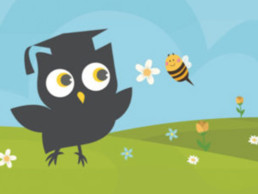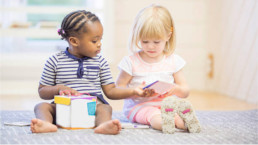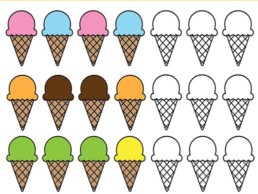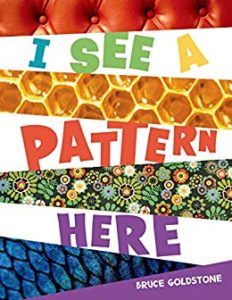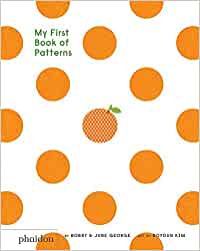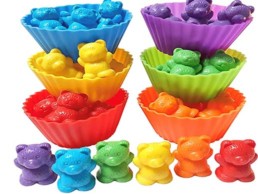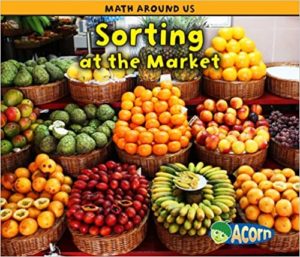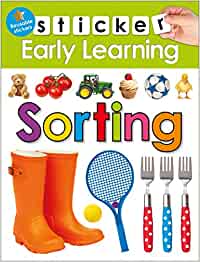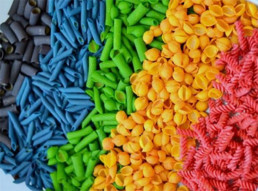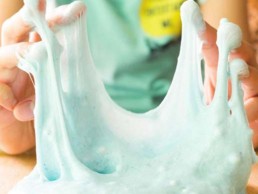Nature Scavenger Hunt
Looking for an excuse to get outside? Get hands on with your natural surroundings by creating a backyard scavenger hunt for your kids! I’ve created a great list of items to find in nature with your little ones. Once you’ve found everything on your list, you can make a collage or nature-inspired craft to hang on your wall. This is the perfect way to keep younger kids engaged while exploring the outdoors.

Teaching baby to share through tricks and tips
We all would love to see our baby share everything from food to toys, without prompting or reminding.
But the truth is that expecting our child to share on demand is unfair, and unrealistic even for an adult.
Think about it: most of us have no problem sharing our meal, or our clothes with people we know, even with people we don’t know. But would you lend your wedding ring to a stranger you just met in a park? How about the key to your home? Yet we expect our children to do just that: share everything, including their most prized possessions (toys) with anyone who asks for them.
Instead of “forcing” your child to share indiscriminately, look at the situation from your child’s point of view first. This will help you teach the value itself, not the habit.
Another thing to keep in mind is that in order to share, baby first has to form the concept of ownership, which doesn’t happen until sometime after their first birthday. At first, they can’t recognize the difference between what belongs to them, and what belongs to others. Once that is learned, they still have to learn the difference between sharing and giving. This will make sharing much easier, because your child will understand that when they share a toy with someone, it doesn’t mean that they will never see it again.
Until baby has learned the above, there are many things that you can do to help them learn to share.
Sharing Tricks and Tips for Beginners:
- Model by example. Share everything you can with your baby. Say the words as you do it “I like to share [my necklace] with you”. This helps baby understand what sharing means
- Start by asking your baby to share their food. Young children love to feed their parents, and they will willingly take part in this activity
- When sharing your things, ask for them back. This will help baby understand that when they share, they will also get their things back. Simply say “I shared it with you, now I would like it back”.
- Keep it simple – only use the word “share”. Do not confuse baby by using alternative words like borrow, lend, return, or any words associated with the act of sharing and returning. This way, you reinforce the concept clearly, which helps your child learn it quickly and easily.
- Begin with short sharing episodes. Ask your baby to share their toy, play with it, then give it back within less than one minute. Over the next few weeks you can slowly extend that time, but still keep it under 5 minutes, so baby realizes that when you say “share” it always means that you will return it.
- Positively reinforce your baby’s efforts. Simply say “thank you for sharing with me, it makes me happy!” Don’t say “nice boy” or “nice girl”, which implies that they are not nice if they are unwilling to share at a particular time. Children should share because they find pleasure in making you happy and in sharing not because they are afraid of being a bad person. Remember to teach the value, not just obtain a desired result.
Once your toddler is comfortable with the concept of sharing, you can practice sharing in social settings with other children similar to how you would in the park
Tricks and Tips for Sharing with Others:
- Bring plenty of toys so your child can share and not have to wait for a turn to play.
- Leave all your child’s favorite possessions at home to avoid forcing your child to share them.
- Play alongside your child to demonstrate how it’s done and to reinforce and encourage your child. “Thank you for sharing your pail with me”; “Your new friend is very happy that you are sharing with them! They like to play with you!”. This also helps your child understand that sharing is a good way to make friends.
- Know when to leave. If your child feels overwhelmed, calmly and discretely leave the playgroup, without reprimanding your child. Talk about the experience: “Sometimes it’s hard to share our toys with people we don’t know, isn’t it?”
- Respecting their needs. If your child is playing with a toy and another child wants it, don’t force your child to share. Instead, support your child and model the correct behavior. For example, you could say “Sam is playing with his toy right now, but he can share it with you later” or “Sam brought other toys that you can play with”. Your child will then have the skills to share, while respecting his own needs.
Originally published with Huffington Post July 2013.
Patterning Activities
An important part of our STEM curriculum at cefa is working with patterns. Understanding patterns is a foundational math skill. You can learn the importance of patterns in this article, or you can just dive straight to the fun part, which is the pattern games and activities.
Learning Opportunities
Children will learn STEM, especially in the area of mathematics. In this game, the greatest learning opportunities are in reasoning, comparison and prediction. As always, the use of mathematical vocabulary greatly enriches these activities. This activity also encourages your child to focus and stay on one task (increases attention span) which contributes to your child’s social and emotional development. Learning patterns can be very simple or very complex. You must always work on the difficulty level your child is comfortable with. Remember, there is all the time in the world to learn – don’t rush! If your game (and the time you spend with your child) is not fun, it’s not worth it.
Ideas for Patterning Activities
You can use anything for patterning, from apples to pebbles, so no investment is required for this activity. You will have to draw patterning cards for your child to follow if you make your own games at home or make a pattern for them first that they can either copy or continue, as shown in my examples below. For example, if you are making patterns with green apples, yellow apples and red apples, you will draw a pattern card that goes like this:
 You can have several patterns for your child, using the same apples:
You can have several patterns for your child, using the same apples:
 Simply adjust to the degree of difficulty that is required. You can start with simple patterns first (AB AB AB AB) then increase the level of difficulty but make sure you are not frustrating your child. This should still be fun and games, not drills. More difficult patterns to try can be AAB AAB AAB, or ABC ABC ABC, AABBC AABBC AABBC, but again, the important thing is that your child will learn to recognize the pattern in order to replicate it. If you make it too hard, your child will just copy and not really get all the important learning that the activity offers.
Simply adjust to the degree of difficulty that is required. You can start with simple patterns first (AB AB AB AB) then increase the level of difficulty but make sure you are not frustrating your child. This should still be fun and games, not drills. More difficult patterns to try can be AAB AAB AAB, or ABC ABC ABC, AABBC AABBC AABBC, but again, the important thing is that your child will learn to recognize the pattern in order to replicate it. If you make it too hard, your child will just copy and not really get all the important learning that the activity offers.
How do you know if your child understands the pattern? Simple! Just ask, as your child is continuing the pattern:
- How does this pattern go? (your child will show you: blue, white, blue, white, blue, and now comes white!)
- How do you know which piece comes next?
Or similar questions. Engage in dialogue, always.
Download the CEFA ice cream patterning worksheet to play at home.
If you have Lego at home, try using that. You can illustrate (using Lego) the pattern you want:

Another household item you can use is pasta. You can make the pattern first for them to follow or they can attempt to continue the pattern by building on to what you have started.
 Here are other ideas you can play with:
Here are other ideas you can play with:
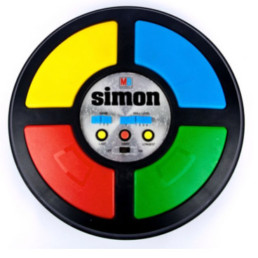
Patterning with Sound
This used to be one of my favorite games as a child. I discovered it at age six. Your child might be too young for this, but you can still pattern with sound using your voice:
beep beep OINK! beep beep OINK!
beep beep OINK! etc…
Or, your body:
Slap your legs once, clap your hands twice, slap your legs once, clap your hands twice, slap your legs once, etc…
You can also use the pans in your kitchen and a wooden spoon! The possibilities are endless!

Patterning by Colour
Use coloured pasta, apples, gummy bears, or Froot Loops cereal!
CEFA Tip: If you are working on colour and your child is just starting, try to keep all the attributes (shape, size) the same.
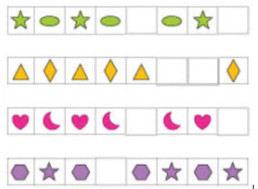
Patterning by Shapes
CEFA Tip: You can cut your own shapes using paper, felt, construction paper or you can print out shapes from the internet and then cut them for your children to sort. If your child can cut them, even better! The internet is full of all kinds of free printable worksheets.

Patterning by Size or Height
CEFA Tip: You can use anything! Try with pebbles from your neighbourhood, shells from the beach, anything that is the same but comes in different sizes.
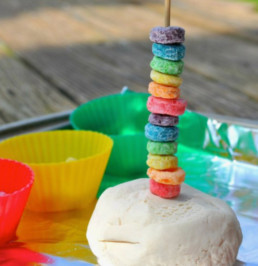
Patterning Towers
These are so much fun! Essentially, they are the same thing as the patterns above, but they are vertical instead of horizontal. You can use Lego bricks (stack them one on top of the other following the pattern you establish), or beads and pipe cleaners or spaghetti!
Patterning Books You Might Like
In order to truly understand these concepts, it is always best for your children to have as many hands-on activities and manipulatives as possible. For patterning, an activity that they can touch, feel and play with is so much better than a worksheet or book.
If your child really has a passion for patterning, or if you need an activity that is educational but does not require as much supervision, then books and workbooks can be fun! Plus, it really depends on your child. Some children love working on workbooks (I was one of them) and can find them entertaining for hours on end, while others prefer real objects. Whatever your child’s preference may be, make sure you always provide manipulatives (rather than only workbooks or activities on paper). Trust me on this one.
A Word of Caution
Although patterning can be a great activity for your child to do alone (once the concept is clear), make sure you always supervise. It can be a choking hazard, depending on the objects you use for patterning. Plus, at this age, children must always be supervised.
Sorting Activities
At CEFA, we teach children attributes as part of our STEM program. One of the ways we do this is by using a variety of sorting games. Each game will teach your child to sort using different attributes.
Sorting is a foundational math skill and is very important to learn, as it helps children describe things and then compare, using attributes (like colour, size, shape, etc.). Games can progress and become more and more complex as children gain sorting skills, and are more descriptive in their attributes.
These games help children sort, classify and order objects by size, shape, colour and other attributes. Sorting games are great activities that your child can play on their own, and can be made with practically anything around the house.
Learning opportunities
Children will learn STEM, especially in the area of mathematics. While you play with your child, encourage your child to describe why they are sorting the objects in that specific manner (i.e. by colour, by type, etc.). You can also invite your child to sort using different attributes during play, or simply by setting up the objects differently (find examples below). In this game, the greatest learning opportunities are in reasoning (which objects go where and why) and use of mathematical vocabulary. This activity also encourages your child to focus and stay on one task (increases attention span) which contributes to your child’s social and emotional development.
A word of caution
Make sure you always supervise your child during sorting activities as it can be a choking hazard, depending on the objects you use for sorting. Plus, at this age, children must always be supervised.
Ideas for sorting games
How to set up your sorting game:
- Put all objects to be sorted in a container or tray.
- Provide a muffin tin, glasses or plastic cups, etc. for your child to begin sorting.
- Begin with two or three colours if your child is very young, and add complexity as your child gains skills.
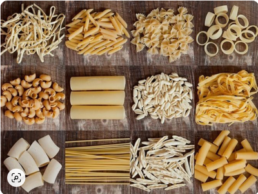
Sorting by type
CEFA Tip: Use pasta or other food you have around the house. You can sort by type by sorting the contents of your fridge or simply sorting fruits and vegetables. With older children, you can sort by proteins, carbs and vegetables. The possibilities are endless!
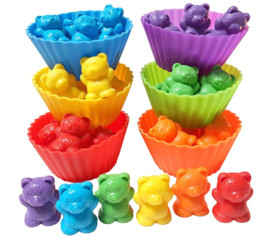
Sorting by colour
CEFA Tip: Use toys you have around the house that you can sort by colour. You can also try fruit, beads, Froot Loops, etc.
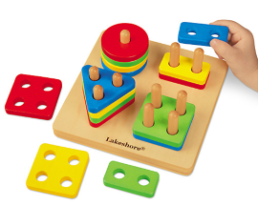
Sorting by shapes
CEFA Tip: You can cut your own shapes using paper, felt, construction paper or anything you want. Alternatively, you can print out shapes from the internet and then cut them for your children to sort. If your child can cut them, even better!
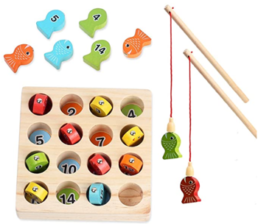
Sorting by numbers
CEFA Tip: You can easily make a game like this at home using sticks, dental floss, magnets, paper “fish” and paper clips.
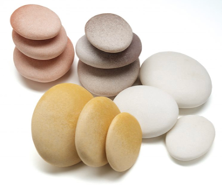
Sorting by size
CEFA Tip: You can sort anything by size! Try with pebbles from your neighbourhood, shells from the beach, toys, the family’s shoes, anything! Children can also line up items from smallest to largest to make it a little harder.
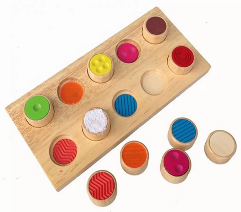
Sorting by texture
CEFA Tip: You don’t need a fancy toy for this, simply play with your child in their room, sorting their toys by texture (soft and cuddly, rough, smooth but hard, etc.).

Sorting by scent
CEFA Tip: Use 5 or 6 different spices and put in spice jars or baby food jars. Make 3 or 4 jars of each scent and have your children sort all the jars by scent. You don’t need to use a lot in each jar, just enough to be able to smell it. If your child is able, opening and closing the jar to smell it is an excellent fine motor skill that will enhance this mathematics game!

Sorting by height
CEFA Tip: All you need for this one is anything you find at home, including your family members! Use mathematical vocabulary such as:
- Short
- Tall
- Shortest
- Tallest
- Taller than
- Shorter than, etc.
Sorting books you might like
In order to truly understand these concepts, it is always best for your children to have as many hands-on activities and manipulatives as possible. For sorting, an activity that they can touch, feel and play with is so much better than a worksheet or book. If your child has a passion for sorting or if you need an activity that is educational but does not require as much supervision, then books and workbooks can be fun! Plus, it really depends on your child. Some children love working on workbooks (I was one of them) and can find them entertaining for hours on end, while others prefer tangible objects. Whatever your child’s preference may be, make sure you always provide manipulatives (rather than workbook or activities sheets only). Trust me on this one. Below are some links where you can purchase sorting workbooks.
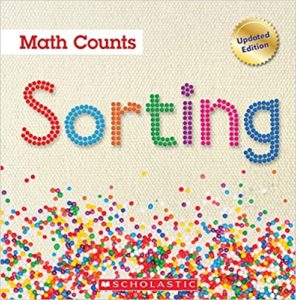
Counts Updated Henry Arthur Pluckrose
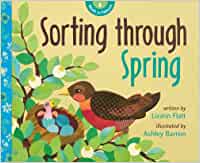
Sorting through Spring Lizann Flatt
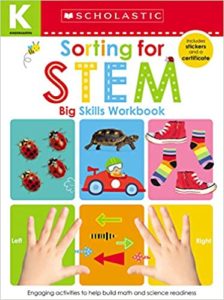
Scholastic Early Learners Kindergarten Workbook
How to Make Coloured Pasta
At CEFA, we use coloured pasta in our sensory bins, especially in our CEFAbaby and Junior Kindergarten One classrooms. This is a fun activity that you can use to teach your children new things plus they can also enjoy the fun of making it with you! Make sure to save the pasta once you are finished and then present it to your children as a sensory bin (see below) another day.
This is an activity that is inexpensive to make and thrilling for children. Plus, you get several days of play out of it as well! Please note this game is safe if children happen to put the pasta in their mouths, although you should avoid when possible.
How to make it
Ingredients
- Water
- Uncooked pasta noodles of any shape and size
- Packets of Kool-aid
- Medium resealable bags or use any containers with tight lids you have around the house.
- A sensory bin. Use anything you might already have at home. I like the ones with lids because they are easy to store and put away when you need (under the bed is the perfect place!). We use these bins for so many different sensory activities in the classrooms, and when my children were little, I always had one in their room that I changed every week or two. Now that they are 18 and 20 years old, that poor bin retired and found its way to one of our CEFA schools If you don’t have something to use around the house, you can purchase one here
Optional Ingredients
- Food colouring – you don’t need it but it makes it so much prettier!
Let’s get started!
- Place 2 cups of pasta into a resealable bag. Use a different bag for each colour and/or variety of pasta you want to make.
- In separate bowls, mix 1 package of Kool-Aid to 1/8 cups of hot water and stir until it is dissolved. You will prepare one bowl per colour you wish to use.
- When all the colours and bags of pasta are ready, you can pour one Kool-Aid mix into one bag of pasta and repeat with the rest of the colours and bags. Now you will have several bags of different colours.
- Seal the bags very tightly and mix them well until all pasta noodles are saturated with colour.
- Open the bags and leave the pasta inside to dry.
- Wait 5 or 6 hours and voilà! The pasta is dry, beautiful, and ready for more play!
- You can put it in the sensory bin and add kitchen gadgets such as:
- Tongs
- Toys
- Any recycled items
- Anything the children can use to measure, fill, pour, count, play with, etc.
Learning opportunities
Children will learn STEM while dyeing the pasta because it’s a science experiment. Questions you can ask your child during the experiment are:
- Will it dry?
- Will it absorb the colour?
- What will it smell like after it’s dry?
- How long will it take to dry?
- Will it feel different?
By helping you measure, mix, describe textures and colours, as well as the intensity of the colours as they get absorbed, they will be using math. As they are mixing and pouring, following all the steps, they are learning sequencing, which is great for reading as well as math.
CEFA tip: Remember to let your child do as much of the process as they are capable of. This means they measure, mix and pour (not you).
The process of making the coloured pasta offers an incredible amount of sensory learning. Children will smell different scents, feel the types of pasta and compare their texture (smooth versus ribbed, straight versus twisted). Sensory learning is especially important for writing. While you play with your child, use vocabulary to describe:
- How the pasta feels
- How the colours smell
- How they taste (if you dare to let them lick their fingers)
Don’t forge to use math vocabulary such as:
- Measuring
- Volume
- Quantities (more than, less than, the same amount, 1 cup, etc.)
- Cold
- Cool
- Warm
- Colour
Describing while using vocabulary is one of the most important learning outcomes at this age. It teaches them reading and mathematics.
This activity also teaches your child patience as they have to wait 5-6 hours until the pasta dries and they can finally see if it works, and then play with it. This activity also improves your child’s ability to focus on one task (attention span) – especially once they get to do other activities with the pasta, like sorting or lacing – which all contribute to your child’s social and emotional development.
Once the pasta is dry, you can use it for sorting activities or for patterning activities.
Things to keep in mind
- Make sure you do this experiment on a surface that is easy to wipe such as the kitchen counter or in the bathtub. You are, after all, handling bags with very colourful liquid!
How to Make Slime
Making slime is such a fun thing to do with your children at home – we do it at school all the time! I am sure that even you won’t be able to resist playing with it! Plus, it will last you about two weeks, which means plenty of fun for days to come!
How to make it
Ingredients
- 1 cup Elmer’s school glue. If you don’t have this at home, you can purchase here
- 1 cup water
- 1 teaspoon Borax mixed into ½ cup warm water (It’s just a teeny tiny bit. See notes on Borax further down in this post)
Optional Ingredients
- Food colouring – you don’t need it but it makes it so much more fun!
- Glitter – you don’t need these either
Let’s Get Started!
- Mix the glue and water together in a mixing bowl (Tip: Set apart some mixing bowls for things like this, that you won’t use in the kitchen later.)
- Mix the Borax solution on a separate bowl
- Add a few drops of colour (your child can learn about colour mixing if you mix two shades together)
- Add the glitter
- Slowly add the Borax solution into the water and glue solution while you mix, and keep adding until you get the consistency of slime
- Voilà! Have fun!
- After you play with it, store it in a resealable bag.
Expand the learning opportunities
- Before you add in the colour or glitter, separate your mix into two or more bowls so you can make different colours of slime with just one recipe! This will allow for other activities during play, like sorting by colour, colour mixing, and even using the different colours to design an art piece!
- Once you make the slime and play with it for a few days, you can add bigger beads to it for a different sensory activity. Plus, if you try to pick out the beads, it will also provide a fine motor activity. Make sure you supervise so it does not become a choking hazard. Beads can be purchased here
- Instead of beads, you can add mini marshmallows, cake sprinkles, or any other similar household items.
What is my child learning during this activity?
Children will learn STEM because they will help you measure, mix, describe textures and colours, see reactions, and predict what will happen.
CEFA tip: Remember to let your child do as much of the process as they are capable of. This means they measure and mix (not you).
As they are mixing and pouring, following all the steps, they are learning sequencing, which is great for reading as well as math.
Once you make it and your child finally gets to play with their creation, it is a sensory activity, important for writing. If you cut with child scissors as you play, it is a fine motor skill, also important for writing.
While you play with your child, use vocabulary to describe how the slime feels in their hands, such as:
- Squishy
- Smooth
- Sticky
You can also use math vocabulary such as:
- Cold
- Cool
- Warm
- Divide
- A lot
- A little
- Colour
Describing while using vocabulary is one of the most important learning outcomes at this age. It teaches them reading and mathematics.
And since we are going through a global pandemic at the moment, which might make everyone feel more anxious, you will be happy to know that playing with slime is a wonderful stress reliever – so, add emotional development to the list of learning outcomes, and bring the slime out when you feel your child could use a soothing break.
A word of caution
- Borax is toxic if ingested in certain quantities. This recipe does not call for dangerous amounts of Borax, but I you want to be extra safe, stay tuned for a future post on how to make non-toxic slime. Slime (and many other sensory activities) require supervision but are essential to your child’s development. As you know, children younger than five require supervision in any case, so why not try the slime and play with them for 15-20 minutes instead? As a teacher and parent myself, I urge you not to deprive babies and toddlers of the learning opportunities and immense fun that these types of activities provide just because you need to supervise.
Having pleaded my case, I also advise you to do what’s best for your child. If your little one is too young to resist putting things in their mouth, then don’t introduce this activity. Our CEFA children are older than 12 months, which is when they begin to understand that not everything goes in their mouth (I said they “begin to understand”, I didn’t say they didn’t find it irresistible).
- Avoid bringing slime into a carpeted area or playing with it on your best furniture as it is a bit sticky.
Lots of great learning in this one! And more importantly, so much fun!
How do you know if your child feels anxious about coronavirus?
No matter how much you try to shield your children from the news, they can sense something has shifted. People seem more anxious; there are new social rules:
don’t hug others or hold their hands, don’t touch your face, don’t touch that book or toy, wash your hands often, stay home. This shift in adult behavior and general sense of unease will inevitably be absorbed by your children, regardless of whether or not they understand what the coronavirus is and how it is affecting the world. Remember, children feel the emotions you and your family members portray. Much more than what you say, how you act, think and feel around them, has the greatest impact. In uncertain times it’s inevitable parents will feel overwhelmed with worry or fear, and that’s okay. However, as much as possible try to find a sense of calm, when you know your children are paying attention.
While I generally recommend refraining from sharing stressful news stories with your children, this only applies if everyone else around them is also not talking about the news. With an unprecedented event, like the coronavirus pandemic, which has had global impact and has changed the daily lives of everyone around them, it’s unreasonable to expect your young child will not hear anything about it or feel the stress. They may have heard you discuss it quietly with your spouse or friends, or sensed there is something wrong going on around them. That alone is enough to cause anxiety in your child, which can be amplified if they are left to make sense of what they have seen or heard on their own, without your guidance and reassurance. If you suspect that this is the case with your child, the best thing to do is to talk about it, and through conversation, encourage them to share their feelings, questions and worries with you, so you can help alleviate their fears.
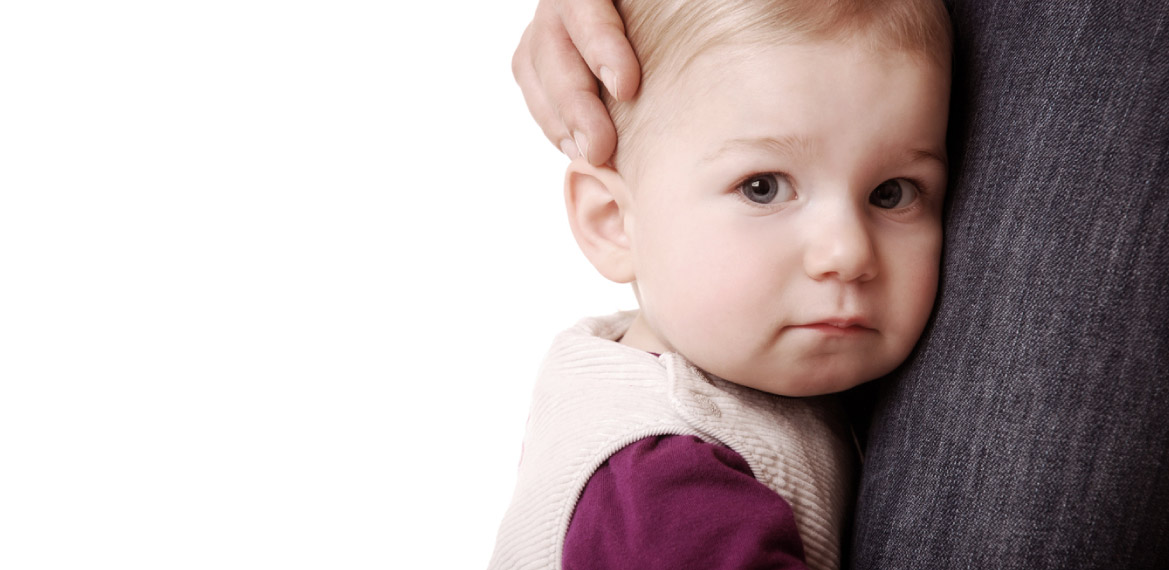
So how do you talk to your children about coronavirus?
At our cefa schools, our students are all younger than five, and for this age group, I suggest you empower your children by sharing with them, very simply, some information about COVID-19, as well as some strategies to deal with it. Remember to keep calm and be reassuring when discussing this topic, as not to provoke anxiety in your child. Another important point to keep in mind when you have the conversation is to explain it to them at a level they can understand and make sense of. Don’t overwhelm your little one by giving too much information.
This can help alleviate their anxiety instead of slowly building it up from whatever they hear from others. If you make it into a discussion, your child will also have the opportunity to ask you questions about it, alleviating any fears they may have had. It will also give your child the impression that you, as a family, will be fine, because you are working on it together.
Here are some key points you can discuss:
- Covid-19 is a virus, just like when some people get the flu (do they remember ever getting the flu, or when you had the flu?)
- The virus does not usually make kids sick, but;
- It’s quite contagious, which is why we have to:
- Keep our hands to ourselves
- Wash our hands often
- Cough into our sleeve
- Not have friends over for now
- Most people get better, just like when they have the flu
Once they know these basic facts, engage them in sharing with you what they are feeling by asking these two simple questions:
- Have you heard anything about it? (listen carefully, ask more questions)
- What do you do to keep healthy?
You can end the conversation by saying something along the lines of: “It looks like we are doing all the right things to stay safe, so we will be fine – what do you think?”
Do not dismiss their worries or minimize them. Just listen and ask them more questions. This is the step that will help in alleviating their anxiety. Once they feel heard, then you can offer some suggestions of how to deal with that particular fear.
Remember to keep the conversation simple and use words they can understand. There is no need to go into too much detail. The idea is to give your children information they can understand, calm their anxiety (listening to their concerns as you discuss, is key) and encourage them to wash hands often.
Of course, you know your child better than anyone else. If you feel your child is very young and has not felt any anxiety coming from you or anyone else regarding the coronavirus, there is no need to bring it up. If your child suffers from anxiety, depression or any other mental health concerns that could be triggered by having this discussion, consult with your child’s doctor or specialist first. If this is the case, keep a close watch for symptoms as your child may get triggered in any case, just by the changes in their environment.
How do you keep your child safe without nagging?
The best way to stay safe is to wash hands often, not touch our face, and not touch things that may be contaminated. It goes without saying that you should not bring your child to public places like parks or supermarkets. As much as you can, stay inside, and insist that everyone who returns home wash hands thoroughly.
It may be difficult for your young child to refrain from touching their face, so instead, sanitize all areas of your home and the toys or other objects your child touches, and focus on washing hands to keep the germs at bay.
For that, I suggest getting a transparent soap with a toy inside, like this one, which serves as both a visual cue and an incentive — so they can get to the toy sooner! Research has shown that children who use that soap wash their hands much more often and more willingly.
Once you talk to your child about it, make sure they are not exposed to the news on TV or other media, and that when you have “adult” conversations about the subject, they are not within earshot of those. If you reassure them on one hand, and then have alarming conversations on the other, you will just undo all of the work you’ve done in calming their anxiety.
How do you know if your child feels anxious about the coronavirus?
Even if your child does not talk about it, they may still feel anxious. Anxiety can take many forms, such as regressing in their development (for instance, going back to having “accidents” after being potty-trained); feeling separation anxiety even if you are still in the house; hitting, biting, or other attention-seeking behavior; even physical symptoms like cramps, headaches, body aches or tummy aches; loss of appetite; they may be more tired or lethargic than usual; they may worry about your safety (for example, have a disproportionate reaction to you sneezing or feeling tired).
If you feel that your child’s anxiety is severe, call a psychologist or your pediatrician to ask for professional advice. If not, the opportunity to discuss it openly with you will alleviate their concerns, as long as you remain calm and positive (and I know this is easier said than done sometimes). If after your conversation they have more questions, answer them reassuringly and using simple language they can understand. Let them know that they will be ok, and that you and your family will too.
Our schools remain open, so don’t hesitate to reach out if you need someone to talk to. You can call your school or e-mail help@cefa.ca – we are here for you!
by
Natacha V Beim
CEFA Founder
